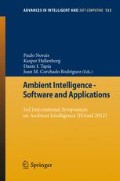Abstract
The main goal of smart home applications can be summarized as improving (or keeping) users’ comfort maximizing energy savings. Holistic management and awareness about users’ habits play fundamental roles in this achievement, as they add predictive, adaptive and conflict resolution capabilities to the home automation system. The present paper presents an application for the thermal comfort that utilizes information from habit profiles - occupancy, comfort temperature and comfort relative humidity - and is designed to be integrated within overall smart home approaches. The application pursues to keep outdoor air quality and thermal comfort controlling shading devices and ventilation elements in unoccupied times and exploiting unobtrusively persuasive technologies in occupied periods. This context aware pre-control phase paves the way to minimize heating and cooling costs.
Access this chapter
Tax calculation will be finalised at checkout
Purchases are for personal use only
Preview
Unable to display preview. Download preview PDF.
References
ASHRAE. Chapters 27 to 29, ASHRAE Handbook – Fundamentals (1997)
ASHRAE. Ventilation for Acceptable Indoor Air Quality. Standard 62-2001 (2001)
ASHRAE. Thermal Environmental Conditions for Human Occupancy. Standard 55-2004 (2004)
Barbato, A., Borsani, L., Capone, A., Melzi, S.: Home energy saving through a user profiling system based on wireless sensors. In: Proceedings of the First ACM Workshop on Embedded Sensing Systems for Energy-Efficiency in Buildings, Berkeley, California, pp. 49–54 (2009)
Bernard, Fisher: Fuzzy environmental decision-making: applications to air pollution. Atmospheric Environment 37(14), 1865–1877 (2003)
Borggaard, J., Burns, J.A., Surana, A., Zietsman, L.: Control, estimation and optimization of energy efficient buildings. In: American Control Conference, ACC 2009, pp. 837–841 (June 2009)
European Commission. Energy Efficiency Plan 2011 – COM(2011), 109 final (2011)
Crosbie, T., Dawood, N., Dean, J.: Energy profiling in the life-cycle assessment of buildings. Management of Environmental Quality: An International Journal 21(1), 20–31 (2010)
Galasiu, A.D., Reinhart, C.F., Swinton, M.C., Manning, M.M.: Assessment of energy performance of window shading systems at the canadian centre for housing technology. Technical report (2005)
Harper, R.: Inside the Smart Home. Springer, London (2003)
Hoes, P., Hensen, J.L.M., Loomans, M.G.L.C., de Vries, B., Bourgeois, D.: User behavior in whole building simulation. Energy and Buildings 41(3), 295–302 (2009)
Humphreys, M.A., Nicol, J.F.: The validity of iso-pmv for predicting comfort votes in every-day thermal environments. Energy and Buildings 34(6), 667–684 (2002)
Iglesias, F., Kastner, W.: Usage profiles for sustainable buildings. In: 2010 IEEE Conference on Emerging Technologies and Factory Automation (ETFA), pp. 1–8 (2010)
Iglesias, F., Kastner, W.: Clustering methods for occupancy prediction in smart home control. In: 2011 IEEE International Symposium on Industrial Electronics (ISIE), pp. 1321–1328 (June 2011)
Iglesias, F., Kastner, W., Cantos, S., Reinisch, C.: Electricity load management in smart home control. In: 12th International IBPSA Conference, Building Simulation 2011, pp. 957–964 (2011)
Intille, S.S.: Designing a home of the future. IEEE Pervasive Computing 1(2), 76–82 (2002)
Kofler, M.J., Kastner, W.: A knowledge base for energy-efficient smart homes. In: 2010 IEEE International Energy Conference and Exhibition (EnergyCon), pp. 85–90 (December 2010)
Kotey, N.A., Wright, J.L., Collins, M.R., Barnaby, C.S.: Solar gain through windows with shading devices: Simulation versus measurement. ASHRAE Transactions 115(2) (2009)
Liang, J., Du, R.: Thermal comfort control based on neural network for hvac application. In: Proceedings of 2005 IEEE Conference on Control Applications, CCA 2005, pp. 819–824 (August 2005)
Santamouris, M.: Solar thermal technologies for buildings: the state of the art. James & James (Science Publishers), London (2003)
Mahdavi, A., Pröglhöf, C.: User behaviour and energy performance in buildings. In: IEWT 2009, Int. Energy Economics Workshop TUV, pp. 1–13 (2009)
Moon, J.W., Han, S.-H.: Thermostat strategies impact on energy consumption in residential buildings. Energy and Buildings 43(2-3), 338–346 (2011)
Fanger, P.O.: Thermal comfort. Danish Technical Press, Copenhagen (1970)
Reinisch, C., Kofler, M.J., Iglesias, F., Kastner, W.: Thinkhome: Energy efficiency in future smart homes. EURASIP Journal on Embedded Systems 2011, 18 pages (2011)
Scientific Committee on Health and Environmental Risks, SCHER. Opinion on risk assessment on indoor air quality. European Commission, Health & Consumer Protection Directorate-General, Brussels (2007)
Author information
Authors and Affiliations
Corresponding author
Editor information
Editors and Affiliations
Rights and permissions
Copyright information
© 2012 Springer-Verlag Berlin Heidelberg
About this paper
Cite this paper
Vázquez, F.I., Kastner, W. (2012). Thermal Comfort Support Application for Smart Home Control. In: Novais, P., Hallenborg, K., Tapia, D., Rodríguez, J. (eds) Ambient Intelligence - Software and Applications. Advances in Intelligent and Soft Computing, vol 153. Springer, Berlin, Heidelberg. https://doi.org/10.1007/978-3-642-28783-1_14
Download citation
DOI: https://doi.org/10.1007/978-3-642-28783-1_14
Publisher Name: Springer, Berlin, Heidelberg
Print ISBN: 978-3-642-28782-4
Online ISBN: 978-3-642-28783-1
eBook Packages: EngineeringEngineering (R0)

